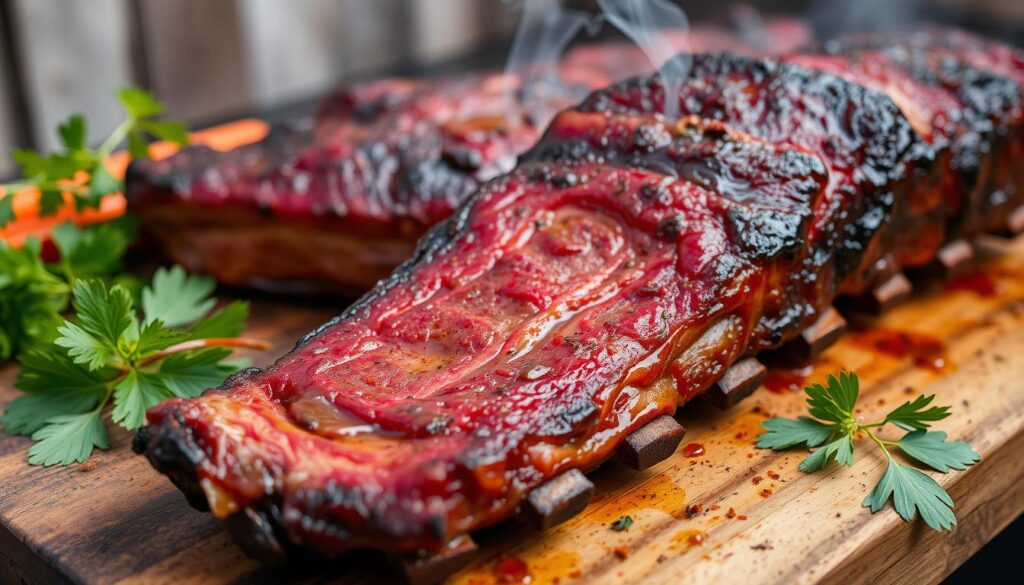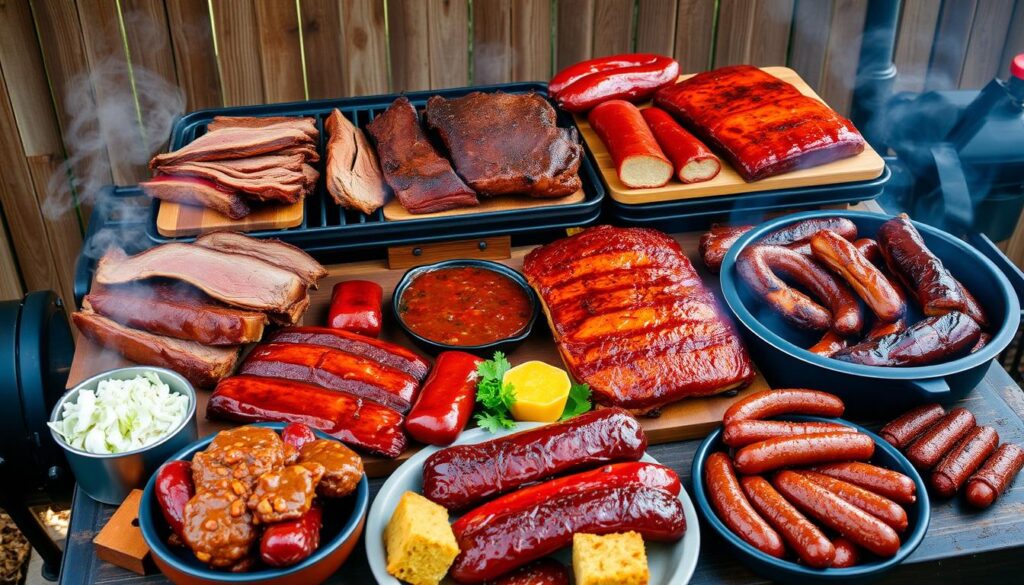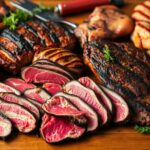Choosing the Right Cuts of Meat for BBQ Competitions
Are you ready to boost your backyard barbecue skills and enter the competitive smoking and grilling world? The key to winning may be in the meat you pick. From brisket to pork shoulder, each type has special traits that can make or break your success. But do you know what makes meats perfect for competitions?
Key Takeaways
- Understand the key factors that judges consider when evaluating competition-level meats, such as marbling, fat content, and muscle fibers.
- Discover the optimal cuts of beef, pork, and other proteins that thrive in the intense heat and scrutiny of BBQ competitions.
- Learn how to select the perfect brisket, pork shoulder, beef ribs, and more to showcase your culinary expertise.
- Explore the regional variations and personal preferences that shape the world of competitive barbecue.
- Uncover the specialized cooking techniques that can help you master the art of competition-ready meats.
Introduction to Competitive Barbecuing
Competitive barbecuing takes the simple act of grilling to a new level. It’s not just about enjoying food with friends. In BBQ competitions, the focus is on skill and precision. This can make the difference between winning and losing.
Understanding the Judging Criteria
The Kansas City Barbecue Society (KCBS) sets the rules for judging in competitive barbecuing. A panel of six judges scores each meat from 2 to 9, aiming for a perfect 180 points. They look at the meat’s look, taste, and how tender it is. They want that perfect mix of flavors and textures.
Differences between Competition and Backyard Barbecue
One big difference is what judges like. They prefer a neat, tender bite, not the super tender ribs for casual barbecues. To win, competitors use special cooking methods, seasonings, and ways to present their food.
| Competitive Barbecuing | Backyard Barbecue |
|---|---|
| Precise cooking techniques and seasonings | Casual, relaxed approach |
| Focused on appearance, taste, and tenderness | Emphasis on enjoying good food and company |
| Striving for a clean, tender bite | Favoring “fall-off-the-bone” ribs |
Competitive barbecuing is exciting and challenging. It’s where love for great food meets the desire to be the best. Knowing how judges score and the differences with backyard barbecues can improve your grilling skills. You could become a true pit master.
Selecting the Best Beef Brisket
Choosing the right beef brisket is key. Look for a packer-trimmed whole brisket with both the point and flat muscles. USDA Prime is top-notch, but Choice is also great for BBQ competitions. Check for fat marbling and flexibility to ensure tenderness and moisture.
Grading and Marbling
The USDA grading system helps judge beef brisket quality. Prime has lots of marbling, making it the best choice. Choice is also good, with enough fat for tenderness and flavor. But, Select grade might not have enough marbling for top competition.
Fat Content and Flexibility
Don’t forget about fat content and flexibility when picking brisket. A bendable brisket means it will be tender. But, a stiff brisket might be too tough for competition.
“A high-quality beef brisket with the right balance of fat content and flexibility can make all the difference in a BBQ competition.”
Choosing the Perfect Pork Shoulder
In competitive barbecuing, the pork shoulder, or pork butt, is key. You need to pick the right cut for tenderness, juiciness, and flavor. Stay away from pork that’s been injected with solutions. This can ruin the natural marbling and fat that make BBQ great.
Choose a pork shoulder that’s reddish-pink and has a pearl-white fat cap. It should have fat marbling in an irregular pattern, or “fat veining.” This shows the pig was well-fed and happy. This fat makes your pork shoulder juicy and tender while smoking.
Avoiding Enhanced or Injected Meat
Enhanced or injected pork might look better, but it’s not worth it. These treatments can lower the meat’s quality and taste. Always go for pork shoulder without added solutions or enhancements. This lets the meat’s natural flavors come through.
Marbling and Fat Distribution
Marbling and fat distribution are crucial for a winning pork shoulder. Look for even fat throughout for a juicy, tasty result. Stay away from pork with too much fat or uneven marbling. These can make your meat dry or cook unevenly.
“The perfect pork shoulder is the foundation of a truly exceptional barbecue dish. By selecting the right natural pork with the ideal marbling and fat distribution, you’re well on your way to impressing the judges and taking home the trophy.”
Best Cuts of Meat for BBQ Competitions
Beef brisket and pork shoulder are top choices in BBQ competitions. But, the best meat for BBQ can change based on where you are. Chicken, turkey, lamb, and goat are favorites in some places. Knowing how to cook each meat is key to winning.
For beef, top picks include:
- Beef clods: These big, tough cuts need careful trimming and slow cooking to be tender.
- Tri-tips: These come from the sirloin and are tasty and tender when cooked right.
- Beef ribs: These can be hard to make, but they offer a rich beef flavor judges love.
Pork shoulder is a classic choice, but some cooks prefer pork ribs or whole hog for something different.
Chicken and turkey are big hits for poultry, with perfect skin and juicy meat being the goal.
Lamb and goat offer unique flavors that can impress the judges.
Success in BBQ competitions comes from perfecting how you prepare and cook each meat. With the right skills, you can make a dish that wows the judges.
Preparing Beef Clods and Tri-Tips
Beef clods and tri-tips are great for BBQ contests because of their special muscle fibers. They are softer than brisket, making them a favorite among BBQ pros.
Understanding Beef Muscle Fibers
Beef clods come from the chuck or shoulder and have different tenderness levels. You can make them tender with slow cooking. The mix of muscle fibers in the clod creates a mix of textures and tastes, perfect for BBQ contests.
Tri-tips, on the other hand, are from the sirloin and have fibers that go in one direction. This makes them easy to cut into thin slices, which are super tender. Because of their simple muscle structure, tri-tips are a top pick for BBQ pros who like things to be consistent.
- Beef clods offer a range of tenderness levels that can be managed through low, slow cooking
- Tri-tips have a single, uniform muscle fiber direction, making them easy to slice across the grain for maximum tenderness
- Both beef clods and tri-tips can be excellent choices for BBQ competitions due to their unique muscle fiber compositions
“Understanding the muscle fiber structure of different beef cuts is key to achieving the perfect texture and tenderness in competition barbecue.”
Mastering Beef Ribs
In BBQ competitions, beef ribs show how good a pitmaster is. Whether you’re using beef back ribs or beef short ribs, you need special skills. These cuts need the right techniques to be tender and full of flavor.
Beef ribs have a lot of connective tissue. This means they need to cook slowly over low heat. This breaks down the tough fibers, making the meat tender. It’s important to watch the cooking time and temperature closely for the best results.

- Pick high-quality beef ribs with lots of marbling and fat. This keeps the meat juicy and tasty during cooking.
- Season the ribs well with a dry rub or marinade. This lets the flavors soak into the meat.
- Cook the ribs low and slow, using smoke and braise techniques. Try to get the meat to an internal temperature of about 200°F. This makes sure the connective tissue is fully broken down.
- Try different wood chips or pellets to give your beef ribs a special smoky taste.
- Let the ribs rest for at least 30 minutes before serving. This lets the juices spread evenly throughout the meat.
With patience, careful attention, and some experimentation, you can make your beef ribs stand out. They’ll be so tender and flavorful, the judges will be impressed.
| Cut | Characteristics | Ideal Cooking Method |
|---|---|---|
| Beef Back Ribs | Larger, meatier ribs with more connective tissue | Low and slow smoking, braising |
| Beef Short Ribs | Smaller, more concentrated flavor with higher fat content | Slow smoking, braising |
“The secret to competition-worthy beef ribs lies in your ability to tame the connective tissue and bring out the natural sweetness and umami flavors in the meat.”
Conquering Pork Ribs
Pork ribs, whether pork spare ribs or pork loin back ribs, need special cooking methods. These methods help break down the tough fibers. This makes the ribs tender and juicy. Competitors use different ways to make these tough cuts perfect for the judges.
Dealing with Connective Tissue
Working with pork ribs is tough because of the connective tissue. This tissue makes the ribs chewy if not cooked right. To beat this, competitors use several tricks:
- Trimming: Removing extra connective tissue makes the ribs softer and tastier.
- Scoring: Cutting the connective tissue shallow helps it cook down better.
- Membrane Removal: Taking off the thin membrane on the ribs ribs helps seasonings go in better and breaks down the connective tissue faster.
With these methods, pitmasters can turn tough pork ribs into delicious, tender pieces. These ribs win over judges at BBQ contests.
“The key to conquering pork ribs is patience and attention to detail. With the right techniques, you can transform even the toughest cuts into melt-in-your-mouth perfection.”
Regional Favorites
Beef and pork are common in competitive barbecue, but some areas have their own special tastes. Chicken, turkey, lamb, and goat are favorites in different places. Knowing these regional tastes can help you win in specific contests.
Chicken and Turkey
In certain areas, chicken and turkey are the main dishes. These meats need to be cooked carefully to avoid drying out. Learning to make smoked chicken or roasted turkey can really impress judges and make your dish stand out.
Lamb and Goat
Lamb and goat are great for those who want to be different. They have strong flavors that can really catch your taste buds’ attention. But, they also need special care to cook well and show off their best taste.
Whether you’re grilling chicken and turkey or trying out lamb and goat, knowing what the judges like can help you win. Tailoring your cooking to the local tastes can make your barbecue unforgettable.

“The true secret to winning a barbecue competition lies in embracing the regional flavors that set your entry apart from the rest.”
Cooking Techniques for Competition Meats
Competitive barbecue needs special cooking skills to impress judges with flavor and texture. Competitors use rubs, sauces, injections, and brining to make each meat bite stand out. These methods are different from backyard grilling, showing the unique challenges of competitive barbecue.
Using well-made rubs is key in competitive barbecue cooking techniques. These dry seasonings add layers of flavor and bring out the meat’s natural taste. Competitors spend a lot of time perfecting their rub recipes, mixing spices, herbs, and other ingredients for a unique flavor.
Sauces are also vital in competition barbecue. They add moisture and boost the meat’s flavors when used to baste it during cooking. Competitors use various sauce methods, like mopping, basting, or injecting it into the meat.
Injections and brining are important too. They fill the meat with a tasty liquid to keep it moist and tender. Competitors try different injection and brining mixes, from simple to complex blends with herbs, spices, and fruit juices.
Knowing these competition barbecue cooking techniques is key to winning. By mixing the right rubs, sauces, injections, and brining, competitors can make barbecue dishes that wow the judges and stand out.
Conclusion
In the world of BBQ competitions, picking the right meat and cooking it right is key. Knowing about beef, pork, and other proteins helps you improve your barbecue. It also helps you understand what judges look for and what people in different areas like.
This guide has given you the knowledge and tools to win at competitions and impress everyone. You now know how to pick the best beef brisket and cook pork ribs like a pro. You’re ready to take your competitive barbecue skills to the next level.
Whether you’re new to BBQ competitions or you’ve been doing it for years, this guide has given you the important tips for meat selection and cooking techniques. With this knowledge, you’re ready to improve your barbecue skills and become a true pit master.

Leave a Reply